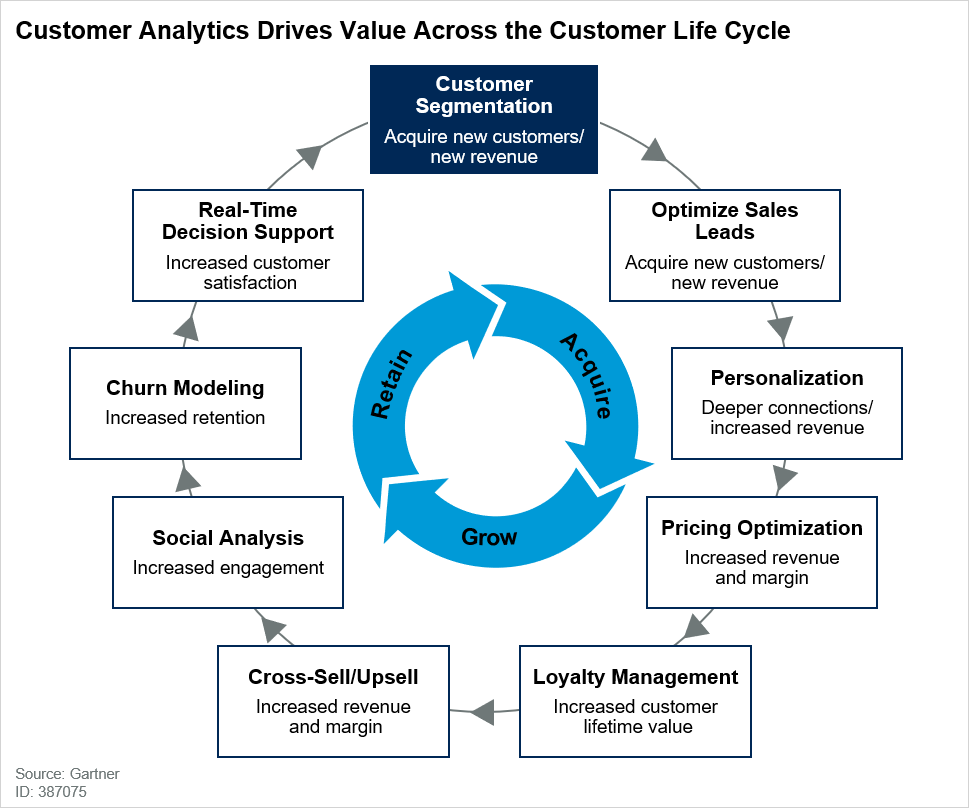Experts predict the Customer Analytics market will top $24 billion by 2025. That growth is driven by a common difficulty facing many of today’s businesses—mountains of big data and no way for non-technical people to make efficient business decisions.
Organizations need customer data to provide the empathetic, personalized experiences customer demand—and to stay competitive. But inside many companies, customer data sits in silos, requiring technical know-how and machine learning skills to access and analyze it.
That’s where Customer Analytics comes in.
Focused on democratizing access to data-driven decision making, Customer Analytics tools empower non-technical users (like marketing and product teams) to make sense of all the data.
Below, we dig into the growing Customer Analytics landscape:
- Questions you can answer with Customer Analytics
- Common features
- Major players in the space
- How Customer Analytics tools fit into the broader BI and analytics landscape
What Questions Can You Solve With Customer Analytics?
Customer Analytics isn’t about data for data’s sake. It’s about the questions customer data enables you to solve, informing marketing, product, and more—empowering teams across the organization to make data-driven decisions and grow the business.
Broadly, there are vital questions Customer Analytics can help you answer.
- Who are my best customers? Create user segments based on common characteristics, including buying behavior, retention, and more.
- What do my best customers do? Know who your best customers are and how they behave within your ecosystem, empowering the business to better identify and nurture key customer relationships and important metrics such as customer lifetime value.
- What actions correspond to revenue? Understand customer behaviors that correlate with purchases or higher spending, bringing you one step closer to increasing that behavior, boosting revenue and improving customer loyalty.
- What actions help me retain my customers? Identify actions that correlate with repeat business and customer retention.

Customer Analytics can also help companies answer more granular, action-oriented questions and enable data-driven strategic decisions. Questions like:
- How can I increase acquisition?
- What’s the best way to communicate with my customers?
- How can I customize my offering, messaging, and marketing to target specific types of customers?
- Which markets can we grow into?
- What content converts the most leads?
- Which marketing channels yield more contacts and reduce customer churn?
Common Customer Analytics Features
Solutions across the Customer Analytics landscape vary, but there are some key features found commonly among them, including:
- Funnel analysis – Create key user flows and funnels to help identify and remedy bottlenecks and friction within the customer experience.
- Market segmentation – Build user segments based on common characteristics your customers share.
- Retention analysis – Discover events highly correlated with one another and create cohorts to analyze. For example, if a user performs Action A, are they more likely to come back and perform Action B? How long does it take them to come back?
- Collaboration and sharing – Public dashboards, scheduled reports, and other key features streamline collaboration and sharing with decision-makers.
- KPI tracking – Easily track KPIs, create dashboards, and visualize your analysis.
- A/B testing – Test product and marketing changes with real customers.
- Data governance – Make it easy and simple for anyone (including non-technical users) to set up their data model in an easy and scalable way—then analyze, digest, and make sense of customer data.
- Revenue analysis – Identify customer actions tied to increased revenue for the business and map how those actions impact revenue.
Big Players in the Customer Analytics Landscape
Among the growing Customer Analytics landscape, there are a few major players:
- Amplitude
- Mixpanel
- Heap
- Indicative
(For a more detailed look at how the major Customer Analytics players stack up, check out our head-to-head matrix.)
Amplitude
Founded in 2012, Amplitude is one of the big players in Customer Analytics. Here’s a look at some of their strengths and weaknesses as a Customer Analytics solution.
Strengths:
- Amplitude makes it easy to share data and collaborate across teams via integrations with Slack and their Amplitude Notebook feature.
- Automated “Smart alerts” reduce manual tracking for new releases and KPI trends.
- For those with more involved and unique data needs, Amplitude’s platform is highly customizable.
Weaknesses:
- Amplitude collects and stores your data in their proprietary warehouse, negating a single source of truth and making it accessible only through their web interface.
- Amplitude doesn’t offer multipath funnels.
- The company isn’t focused on offering custom support.
- For more complex statistical analysis, users may find Amplitude lacking (for example, the tool doesn’t support variance-based analysis).
- Amplitude offers a lot of features, which can make onboarding a more complicated and lengthy process.
Mixpanel
Mixpanel, another major player in the Customer Analytics market, was founded in 2009. Have a look at some of the platform’s key strengths and weaknesses.
Strengths:
- Mixpanel helps users create an innovation loop, iterating on products from end to end
- Unlike many analytics solutions, Mixpanel strikes a good balance between serving beginner and advanced user levels.
Weaknesses:
- Mixpanel collects and stores your data in their proprietary warehouse, negating a single source of truth and making it accessible only through their web interface.
- The data setup process can be confusing because Mixpanel doesn’t include a mechanism for users to reference their data model while building queries.
- Mixpanel isn’t known for stellar support. The company doesn’t offer live chat support, and response times for other support channels can take up to 48 hours.
- “No embedded analytics and limited export options”
Heap
Another player in the Customer Analytics space, Heap was founded in 2012. Here are some of the strengths and weaknesses Heap users report.
Strengths:
- The platform’s unique “Autocapture” feature automatically collects all data, regardless of which a company cares to track
- Heap makes it easy for less data-savvy users to manage data from within the Heap interface.
- The platform organizes data well, showing users what their events actually correspond to.
- Heap offers many self-service integrations from CRM and payments to testing and pipelines.
Weaknesses:
- Reports suggest Heap scripts can significantly slow down site performance and speed.
- Heap’s Autocapture feature can lead to bloated events and properties, potentially requiring a dedicated position to clean up and monitor the data.
- Some key analysis tools aren’t available in Heap, including session analysis and bounce rate, segmentation analysis, cohort analysis, and more.
- Heap’s pricing model is a bit opaque—and out of reach for many businesses. Once users move past the free plan, costs can jump up significantly, regardless of your event count.
Indicative
The last Customer Analytics solution we’ll look at is Indicative (yes, that’s us!) Have a look at some of the key strengths and weaknesses Indicative hears about from customers.
Strengths:
- The only Customer Analytics platform to connect directly to your data warehouse, Indicative avoids the errors inherent in duplicate data collection and maintains your single source of truth.
- Indicative offers a powerful funnel analysis tool and the only provider with multipath funnels.
- Our market-leading top-of-funnel tools make Indicative the best option for marketers, in addition to product teams and data analysts.
- Easy to digest visualizations help users better conceptualize and understand their data.
- The most generous free plan, offering up to 50 million events per month—a great choice for early-stage companies.
- With email support available to all customers and response times under X, our support team is best-in-class.
- Simple, no-SQL interface makes it easy for non-technical users to get the most out of their data.
- An excellent complement to BI tools, Indicative is great for ad hoc analysis and quick results that can take hours in Looker and Tableau.
- Our customer-driven roadmap means you tell us where you want the platform to go—and we build it.
Weaknesses:
- Indicative currently offers limited predictive analytics. It’s designed for users who come with a hypothesis or analysis idea already in hand.
- Indicative offers fewer options for collaboration when compared to other players in the Customer Analytics space.
Tools Commonly Used with Customer Analytics
Customer Analytics tools are rarely used alone. They don’t replace a data collection or business intelligence (BI) tool. Instead, Customer Analytics should work hand-in-hand with your existing analytics stack.
Complimentary Analysis Tools
Customer Analytics tools are often considered a subset of BI tools—because they work seamlessly along with them. BI tools (like Looker and Tableau) power much of the data analysis happening in today’s companies, but they are challenged by the very types of analyses provided by Customer Analytics:
- They can’t handle the complex analyses that the modern buyer’s journey requires
- They require SQL queries that make data difficult (and time-consuming) for non-technical people to access
This is where Customer Analytics becomes a perfect complement to your BI tool—democratizing access to data with a no-SQL interface and offering quicker access to more complex data analyses.
Integration Tools
To bring all your customer data together into one platform, Customer Analytics platforms integrate with myriad other tools your organization uses—including data warehouses, data tracking and collection tools, customer data platforms (CDP), and more.
Here are a handful of tools Customer Analytics platforms commonly integrate with:
- Google Analytics – Used atop web analytics, Customer Analytics gives you a more in-depth, holistic view of customer journeys, before and after conversion.
- Google Tag Manager
- Segment
- Snowplow
- mParticle
- Google Cloud Platform (GCP)
- Amazon Web Services (AWS)
What Lies Ahead for the Customer Analytics Landscape
As mentioned above, the Customer Analytics industry is expected to grow rapidly over the next several years. We’ve covered the basics of the Customer Analytics landscape as it currently exists, but this is a market that’s on the move. Here’s where we think the industry is headed:
- Democratized data access – Access to data continues to grow, making it easier than ever for every company to have a data warehouse and more effectively own and leverage their data.
- Data increasingly translates to value – In addition to greater access to data, the maturing data analytics landscape makes it easier to turn that data into business value, reducing costs and time-to-value.
- Growing value of data – We’re progressing toward a world where better tools enable companies and individuals to move up the insight pyramid, making more informed, effective, and certain decisions.
- Predictive analytics – Companies are already investing heavily in predictive analytics that automatically identifies actions that lead to engagement and retention.


 Indicative Team
Indicative Team

